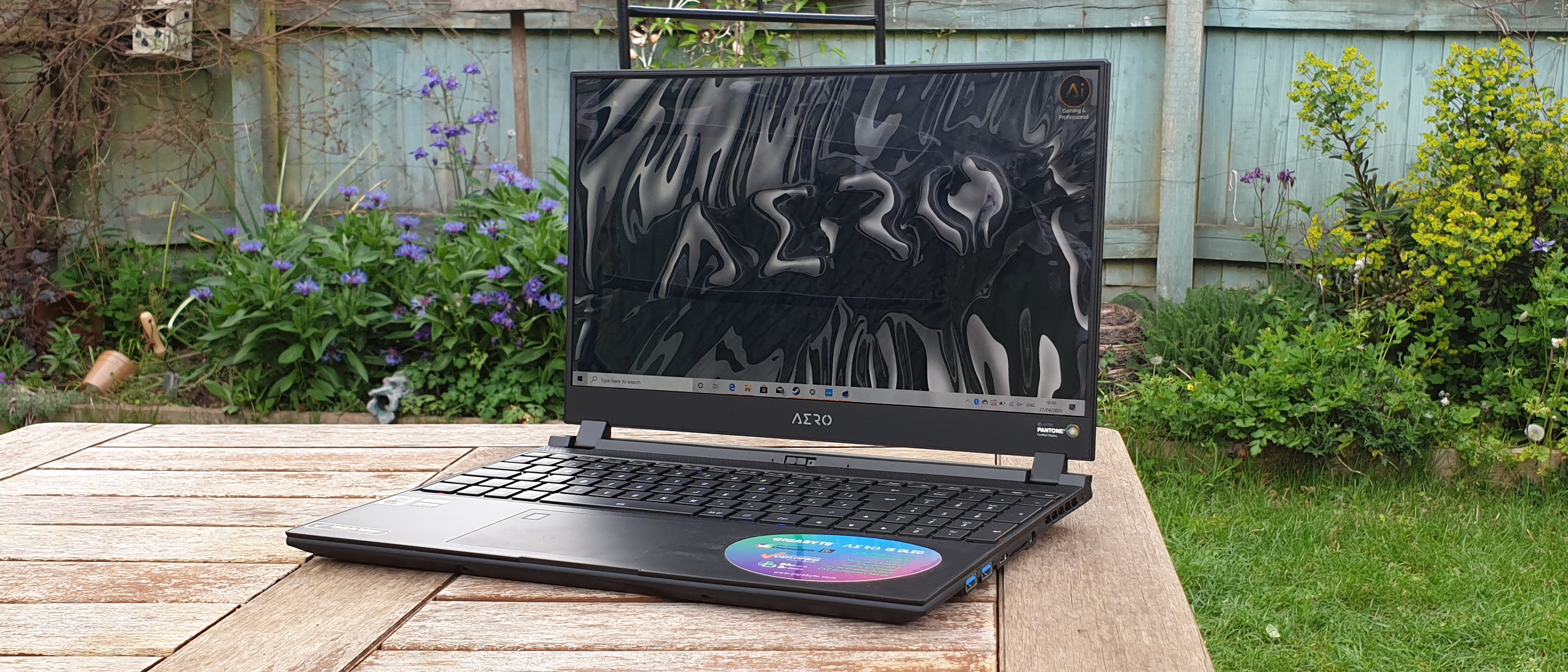TechRadar Verdict
The Gigabyte Aero 15 OLED (2020) is yet another brilliant laptop aimed at creative professionals. New for 2020 are updated components, including new Intel and Nvidia tech, but it's that gorgeous OLED screen that continues to win us over.
Pros
- +
Fantastic OLED screen
- +
Good port selection
- +
Decent battery life
- +
Powerful
Cons
- -
Expensive
- -
Glowing keyboard could put you off
- -
Webcam placement at bottom of screen
Why you can trust TechRadar
The Gigabyte Aero 15 OLED (2020) is the latest version of the Taiwanese company’s flagship laptop, renewed and refreshed for 2020 with 10th generation Intel processors, and Nvidia’s new RTX 2070 Super mobile graphics cards.
As with last year’s model, the Gigabyte Aero 15 OLED (2020)’s star attraction, apart from its cutting-edge components, is its gorgeous Samsung AMOLED screen, which is also Pantone color-calibrated, with a 100,000:1 contrast ratio and 100% support for the DCI-P3 color gamut.
That alone should tell you that the Gigabyte Aero 15 OLED (2020) is a laptop that's aimed primarily at creative professionals who require maximum color accuracy, for example photographers and video editors.
Of course, the Gigabyte Aero 15 OLED's specs (we’ll get to those shortly) mean it’ll make a formidable gaming laptop as well, but playing games isn't this machine's primary focus.
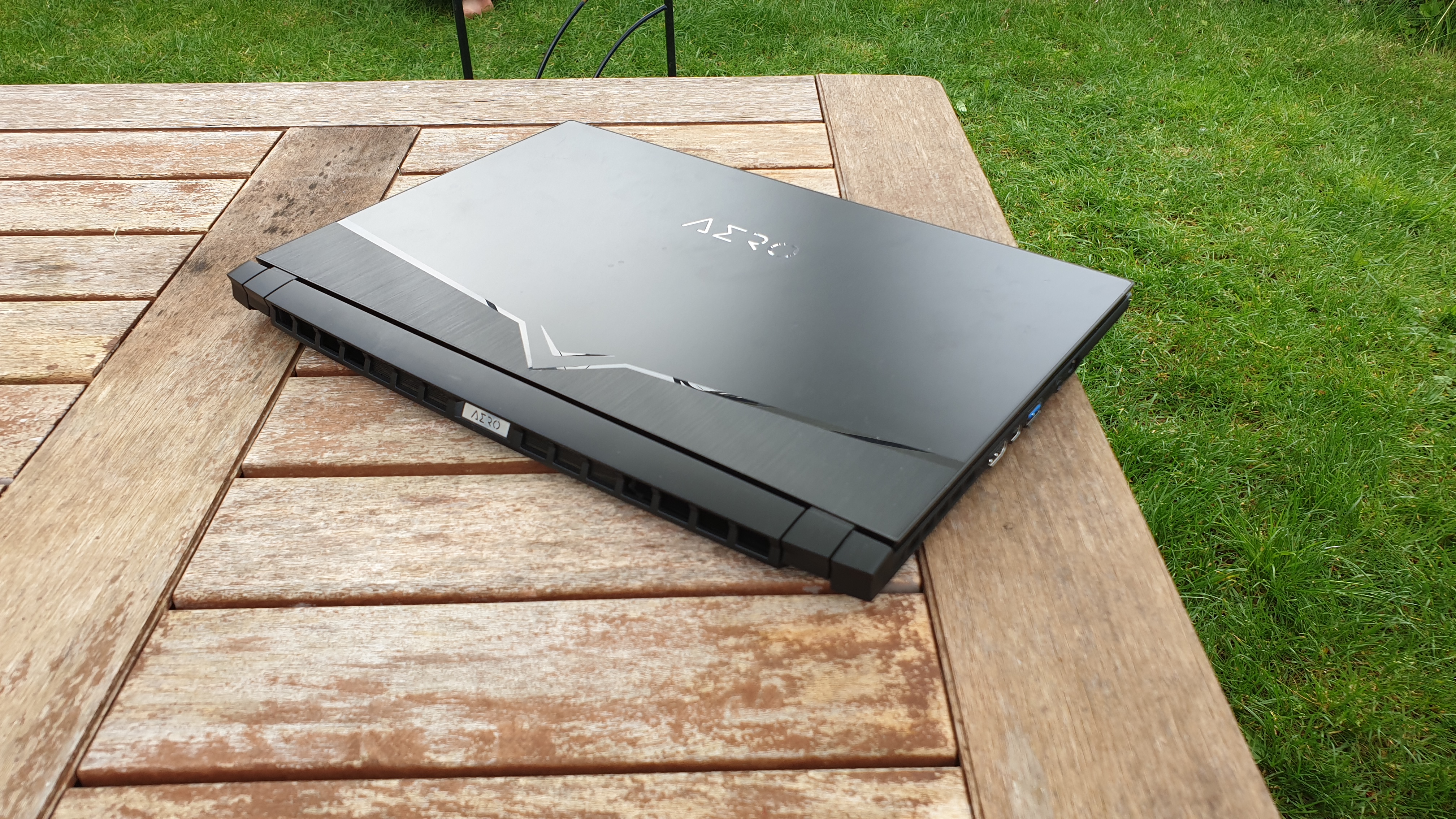
Here are the specs of the Gigabyte Aero 15 OLED (2020) sent to TechRadar for review:
CPU: 2.3GHz Intel Core i7-10875H (8-core, 16MB cache, up to 5.1GHz)
Graphics: Nvidia GeForce RTX 2070 Super Max-Q (8GB GDDR6)
RAM: 16GB DDR4 (2,933MHz)
Screen: 15.6-inch UHD (3840 x 2160) AMOLED
Storage: 512GB SSD (PCIe)
Ports: 3 x USB 3.2 Gen1, HDMI-out, Gigabit Ethernet, 1 x Thunderbolt 3, 1 x Mic-in, 1 x Headphone-out, 1 x UHS-II SD Card Reader, 1 x mini DisplayPort 1.4
Connectivity: Killer LAN E2600, Wi-Fi 6; Bluetooth 5.0
Weight: 4.4 pounds (2kg)
Size: 14 x 9.8 x 0.78 inches (356 x 250 x 20mm); W x D x H
Price and specifications
Having a 4K OLED screen that’s professionally calibrated, along with a sleek design and some of the best mobile tech around means the Gigabyte Aero 15 OLED (2020) isn’t going to come cheap – its starting price is £1,699 (around $2,100, AU$3,300), which gets you a six-core 10th generation Intel Core i7-10750H processor, 16GB RAM, 1080p IPS screen and Nvidia GeForce GTX 1660 Ti.
Stepping up in price, the model we reviewed has an 8-core Intel Core i7-10875H processor, 4K AMOLED screen, 16GB of RAM and Nvidia GeForce RTX 2070 Super. This costs $2,699 / £2,499 / AU$4,399.
Meanwhile, the fully specced-out version with an Nvidia RTX 2080 Super GPU, 10th generation Intel Core i9-10980HK, 1TB hard drive and 64GB of RAM will set you back £4,299 (around $5,300, AU$8,300).
So, this is an expensive laptop, but it’s not ridiculously priced considering what you're getting for your money. For example, the 16-inch MacBook Pro, with roughly comparable specs to the mid-range version, costs $2,799 / £2,799 / AU$4,399 – and that’s with an older CPU and a screen that's not as good as the one on the Gigabyte Aero 15 OLED (2020).
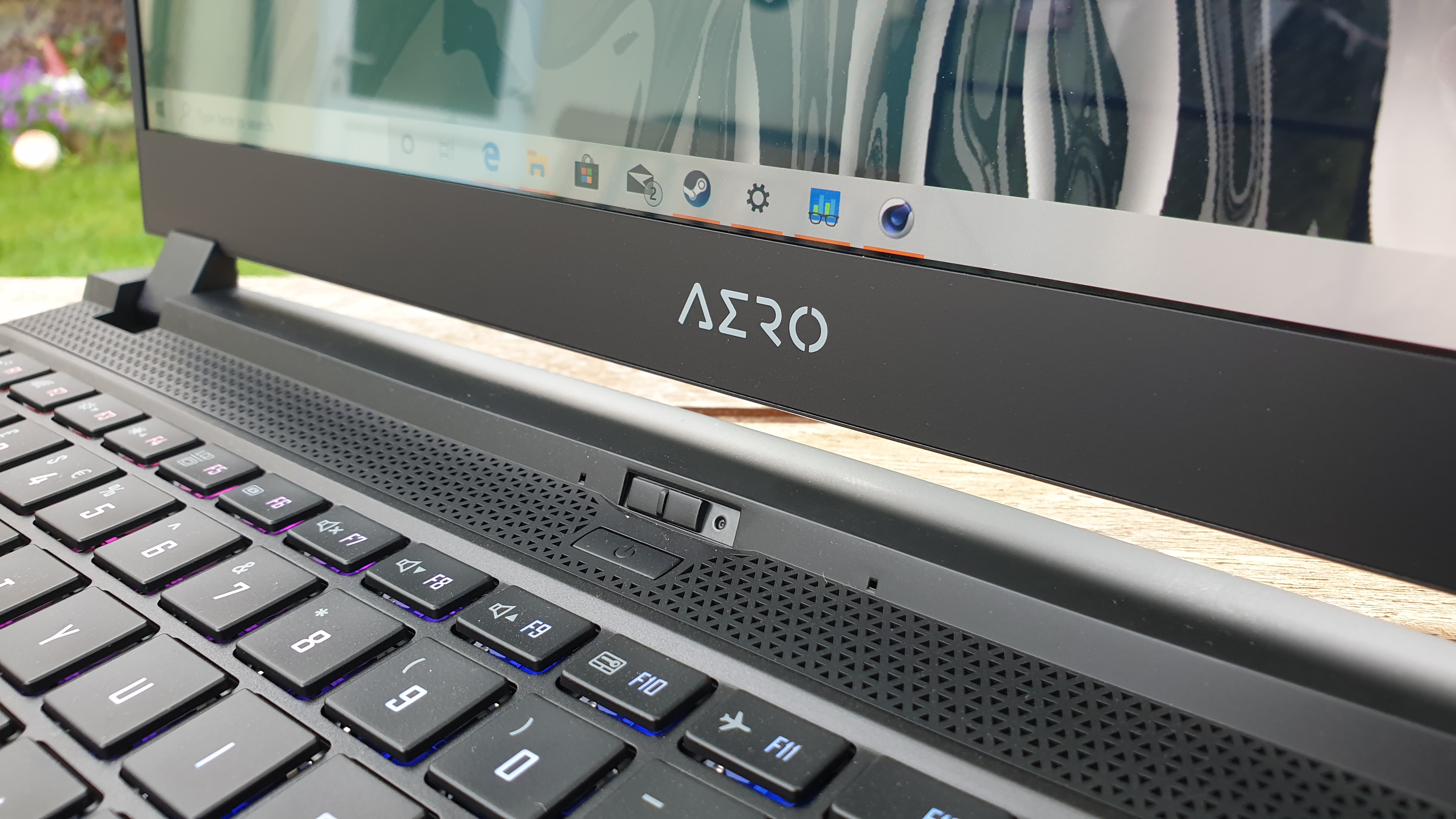
Design
The design of the Gigabyte Aero 15 OLED (2020) is functional and attractive. As this is primarily a pro laptop, its design is muted enough that you won’t get strange looks if you whip the laptop out at meetings or in the office.
It has an all-black design, with an illuminated ‘Aero’ logo on the lid. With dimensions of 14 x 9.80 x 0.78 inches (355 x 248 x 19.8mm) and a weight of 4.40 pounds (2kg), this is an impressively thin and light laptop considering the powerful specs inside.
That’s slightly thicker than the 16-inch MacBook Pro, and the same weight. However, the Gigabyte Aero 15 OLED offers a far better selection of ports than Apple’s Pro laptop. On the left-hand side you get a full-size HDMI port, a mini DisplayPort, USB 3.0, Ethernet, and an audio jack for a headset.
On the right-hand side are two more standard USB ports, a USB-C port, an SD card reader and a power port. Unlike the MacBook Pro you can’t charge the laptop via the USB-C port, but in all other respects the Gigabyte Aero 15 OLED beats the Apple laptop when it comes to port selection.
We’ve often complained how the MacBook Pro – billed as a laptop for professionals – only comes with four USB-C ports. For professionals who use older peripherals, or photographers who need a card reader, it means you’re going to have to buy an adapter.
However, with the Gigabyte Aero 15 OLED this isn’t necessary. Need to connect it to a monitor or projector? Use the HDMI. Taken photos on a digital camera and need to edit them? Plug the memory card straight in.
This makes it a much more versatile professional laptop, and while it is slightly thicker than the MacBook Pro, it’s not huge, and it shows that you can still have a slimline laptop without sacrificing ports.
When you open the Gigabyte Aero 15 OLED it looks a lot more like a gaming laptop than it does from the outside, mainly thanks to the keyboard with RGB LED backlighting (thankfully, this can be turned off if you don’t want a mini disco lighting up the boardroom when you’re in a meeting).
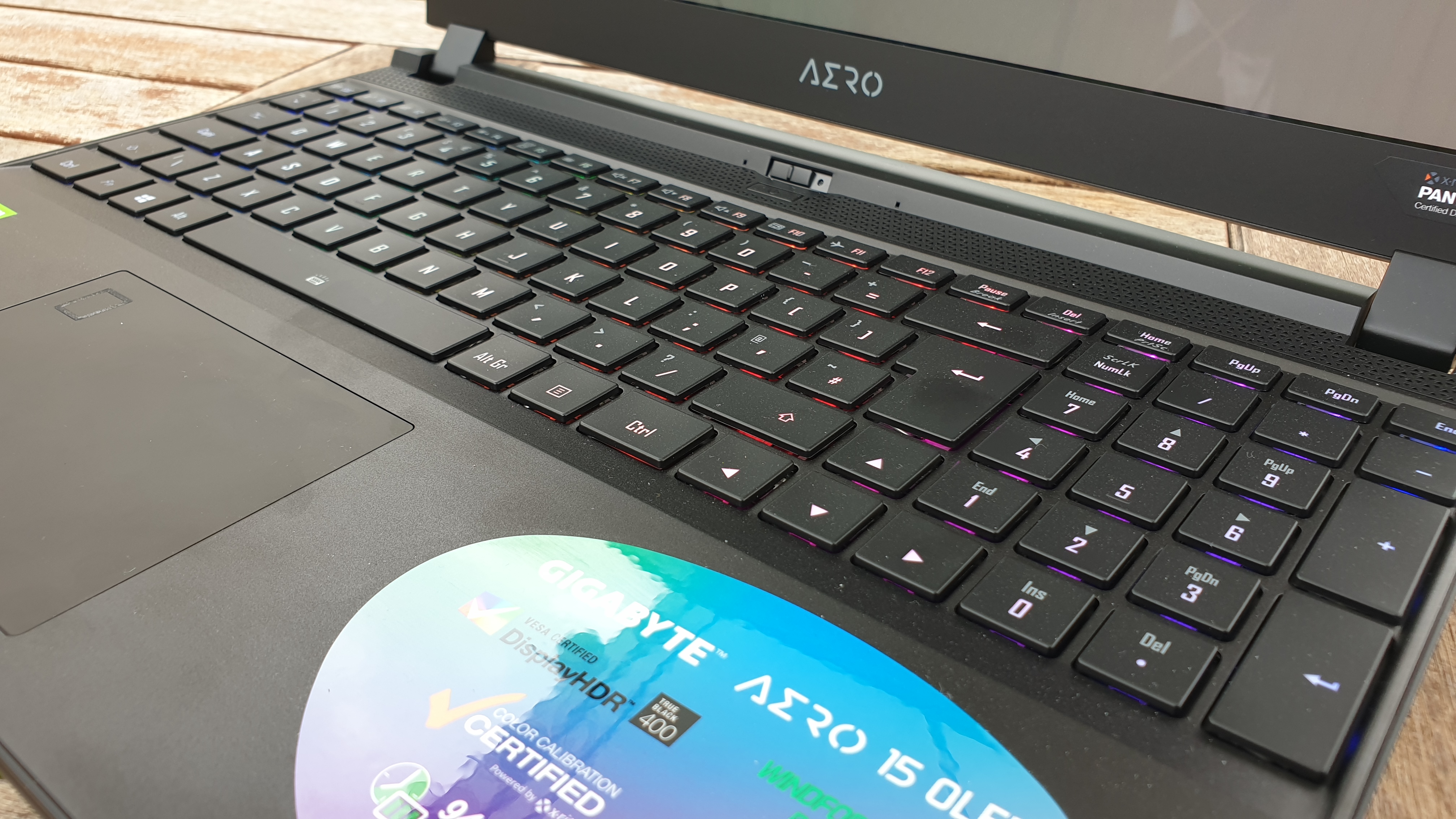
The keyboard itself feels good to type on – the keys are nice and large, and have good travel, and there’s even room for a numpad. It’s one of the more comfortable laptop keyboards we’ve used.
The trackpad below it a decent size, and it's fast and responsive. You’ll still want to connect a mouse for most creative applications – and certainly for games – but for day to day use, or if you need to use the laptop in a rush or on the move, it does the job well. There's also a fingerprint reader built into the top-left of the trackpad for biometric login to Windows 10.
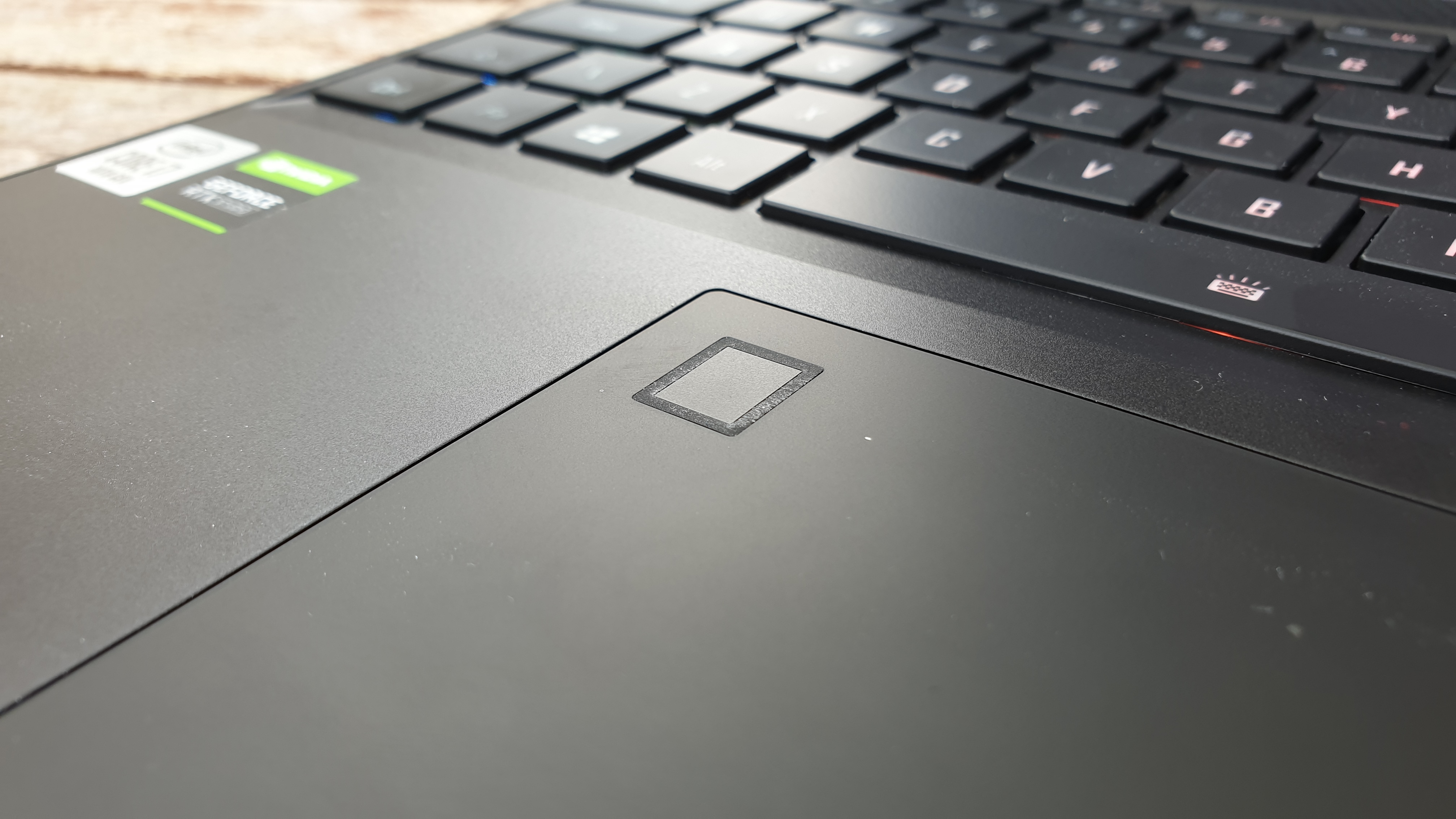
Of course, the star of the show is the gorgeous 15-inch OLED screen. We’ll go into more detail about how it performs in a moment, but design-wise, the Gigabyte Aero 15 OLED has been built to ensure that all your focus is on that beautiful screen.
To that end, the bezels around the display are impressively thin, which also helps to keep the overall size of the laptop down, despite the generously sized screen.
This does necessitate a compromise, however, with the webcam moving from its traditional spot at the top of the screen to the bottom. While this allows the top bezel to remain thin, it means the webcam is positioned low and angled upwards – a setup that some people aren’t too fond of, as it can be unflattering.
There's a physical cover that you can slide over the webcam when it's not in use, which is a nice privacy feature to have, as it ensures that your webcam isn’t broadcasting you without your knowledge.
Overall, the design of the Gigabyte Aero 15 OLED is simple and elegant, with a thin and light build that doesn’t compromise (too much) in the way of functionality.
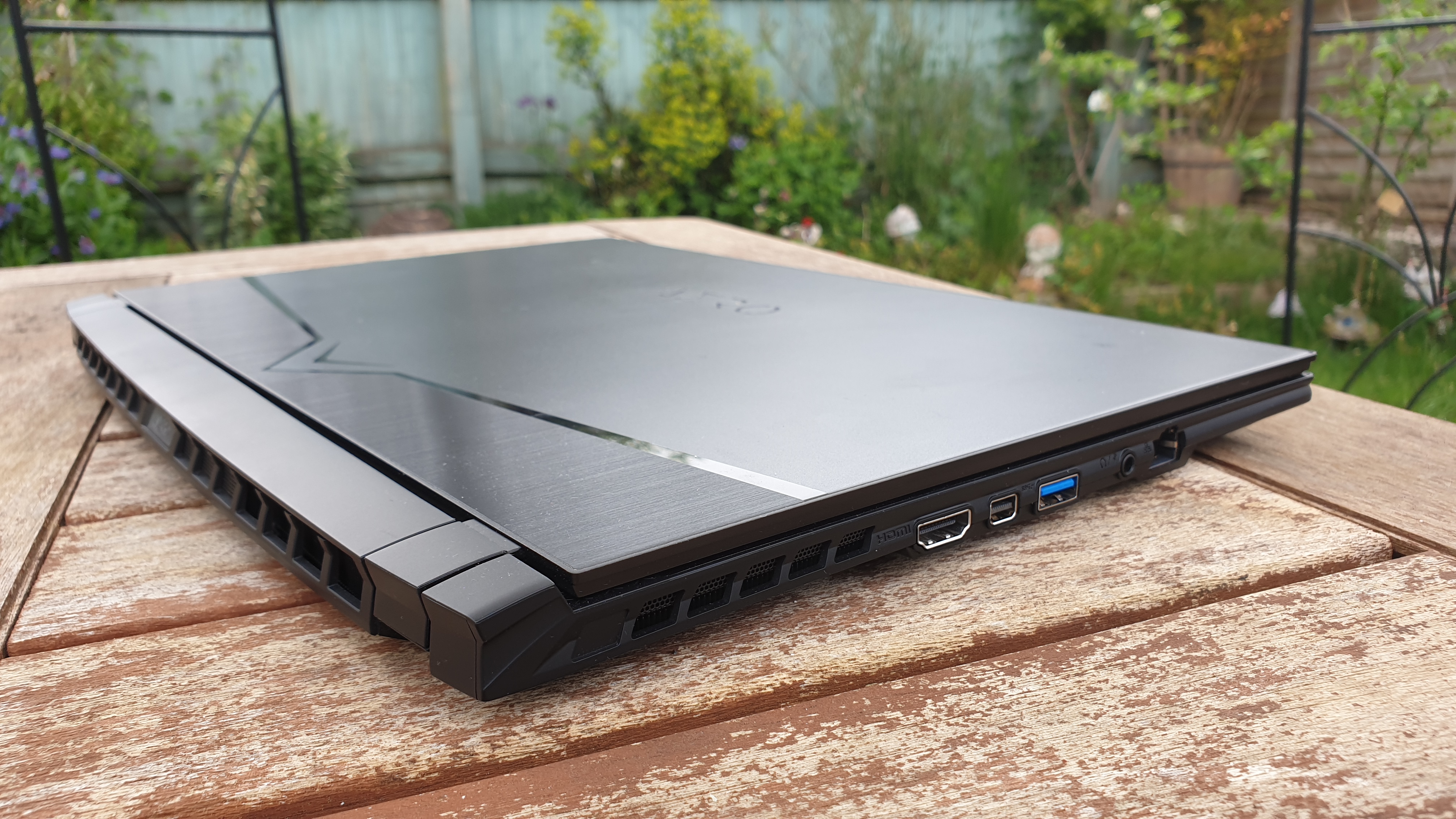
Here's how the Gigabyte Aero 15 OLED fared in our suite of benchmark tests:
3DMark Sky Diver: 29,704; Fire Strike: 16,785; Time Spy: 7,319
Cinebench R20: 2,477
Geekbench 5 Single-Core: 1,191; Multi-Core: 5,458
PCMark 10 Home: 4,414
PCMark 10 Battery Life: 5 hours 1 minutes
Battery Life (TechRadar movie test): 4 hours 50 minutes
Total War: Three Kingdoms: 195fps (1080p, Low) 62.4fps (1080p Ultra)
Metro Exodus: 153fps (1080p, Low), 54.44fps (1080p, Ultra)
Performance
As you’d expect of a laptop with this kind of hardware, the Gigabyte Aero 15 OLED performs brilliantly, both when running creative apps and for gaming. The new RTX 2070 Super mobile GPU (as well as the RTX 2080 Super) offers a decent upgrade over the previous non-Super variant, and combine this with the new 8-core Intel processor and you’ve got an incredibly powerful laptop that can handle multiple tasks at once without too much issue.
While the RTX line of GPUs are primarily gaming-focused, there are creative benefits to them as well.
As an ‘RTX Studio’ laptop, the Gigabyte Aero 15 OLED comes with Nvidia’s Studio drivers, rather than its game-ready ones, and these are tuned for creative applications, so the likes of Adobe Premiere Pro, Redcine-X Pro and Autodesk perform especially well.
Digital artists, 3D modelers and game developers can use Nvidia’s ray tracing features to create scenes with believable lighting effects, and the Aero 15 OLED can handle editing raw 8K video files – a very intensive process.
Of course, it's also a stellar performer when it comes to games, and if you have the model with an RTX graphics card you can enjoy ray tracing effects in games such as Metro Exodus and Control.
We played both on the Gigabyte Aero 15 OLED, and they looked fantastic. Performance was good as well – Metro Exodus managed 54 frames per second at ultra settings, and with a little bit of tweaking you’ll get over that magic 60fps mark with ease.
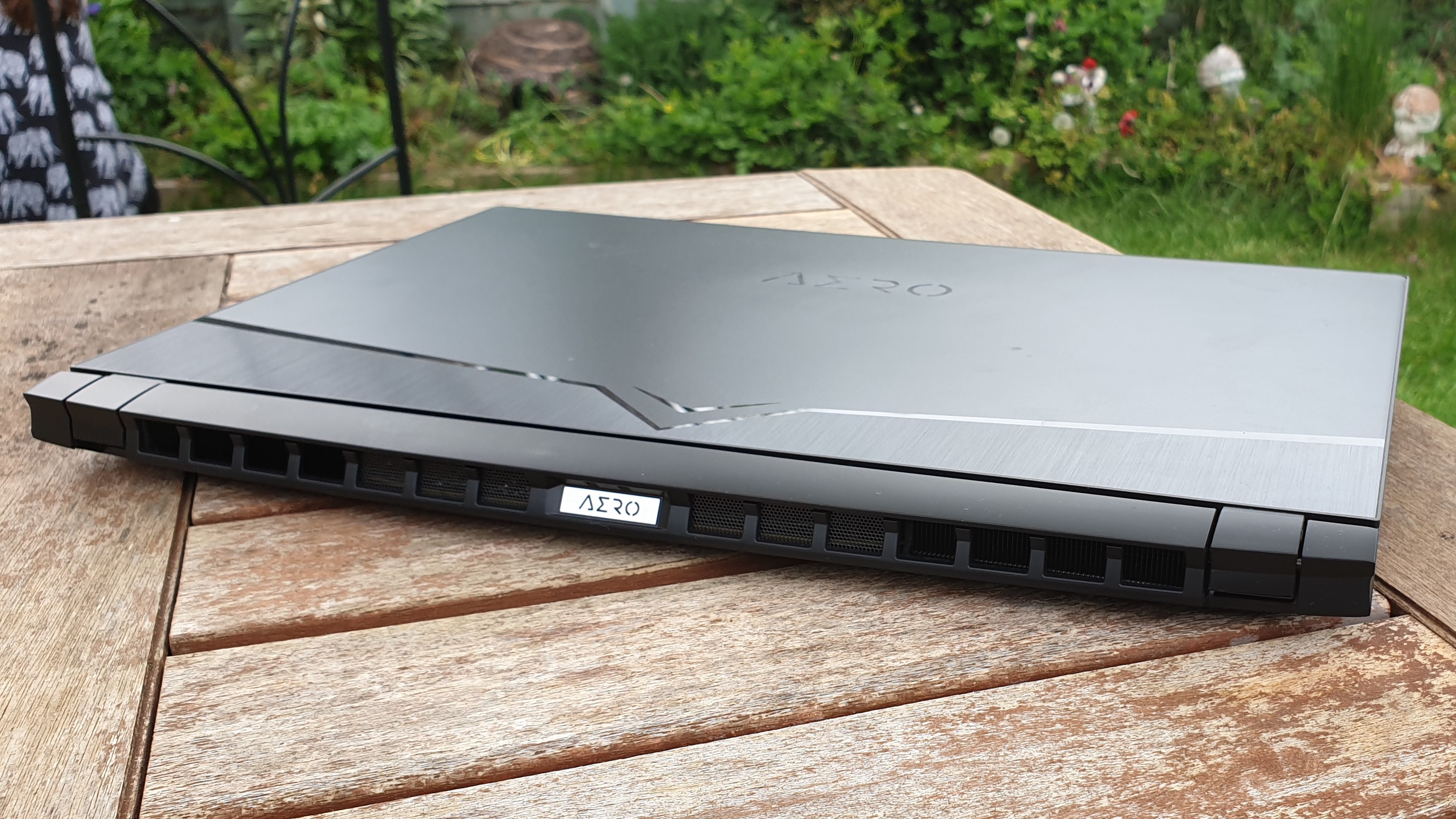
We should note, however, that this was at 1080p, so we weren’t making the most of the 4K screen. If you do want to play at 4K, the frame rates drop to 26fps – this is at ultra settings, mind you, but games feel a lot more sluggish. Lowering the quality to ‘medium’ boosts the frame rates above 30fps.
So, there’s a hefty hit when playing at 4K, but we have to say that with ray tracing and other advanced graphical effects, games at that resolution on the OLED screen look amazing. But the RTX 2070 Super struggles at that resolution.
One thing we noticed, however, is that while the 4K OLED screen is indeed lovely, it’s very reflective. This is an issue when the keys are glowing in all their RGB glory, as they're reflected in the screen, which can get pretty distracting.
The Gigabyte Aero 15 OLED, then, is a better professional laptop than it is a gaming laptop; there are dedicated gaming laptops out there that offer better performance and value.
Battery life
When it comes to battery life, the Gigabyte Aero 15 OLED fares pretty well considering the powerful components inside. In our battery life benchmark, which plays a looped 1080p video at 50% brightness, the Gigabyte Aero 15 OLED lasted almost five hours.
That’s pretty good for a powerful workstation/gaming laptop, as these are often notorious for short battery lives of only a few hours. The Aero 15 OLED also lasted five hours in the PC Mark 10 battery test, which replicates day-to-day tasks.
So, while it’s not the longest-lasting battery, it’s one of the better performers for a workstation laptop. However, the MacBook Pro comfortably beats the the Aero 15 in the battery department.
In daily use, we found that battery life varies dramatically depending on what you’re doing. We gave Planet Zoo a play (as we’re missing out on going to real zoos at the moment), and after around 45 minutes the battery was almost depleted. So, you won’t want to leave your charger behind.
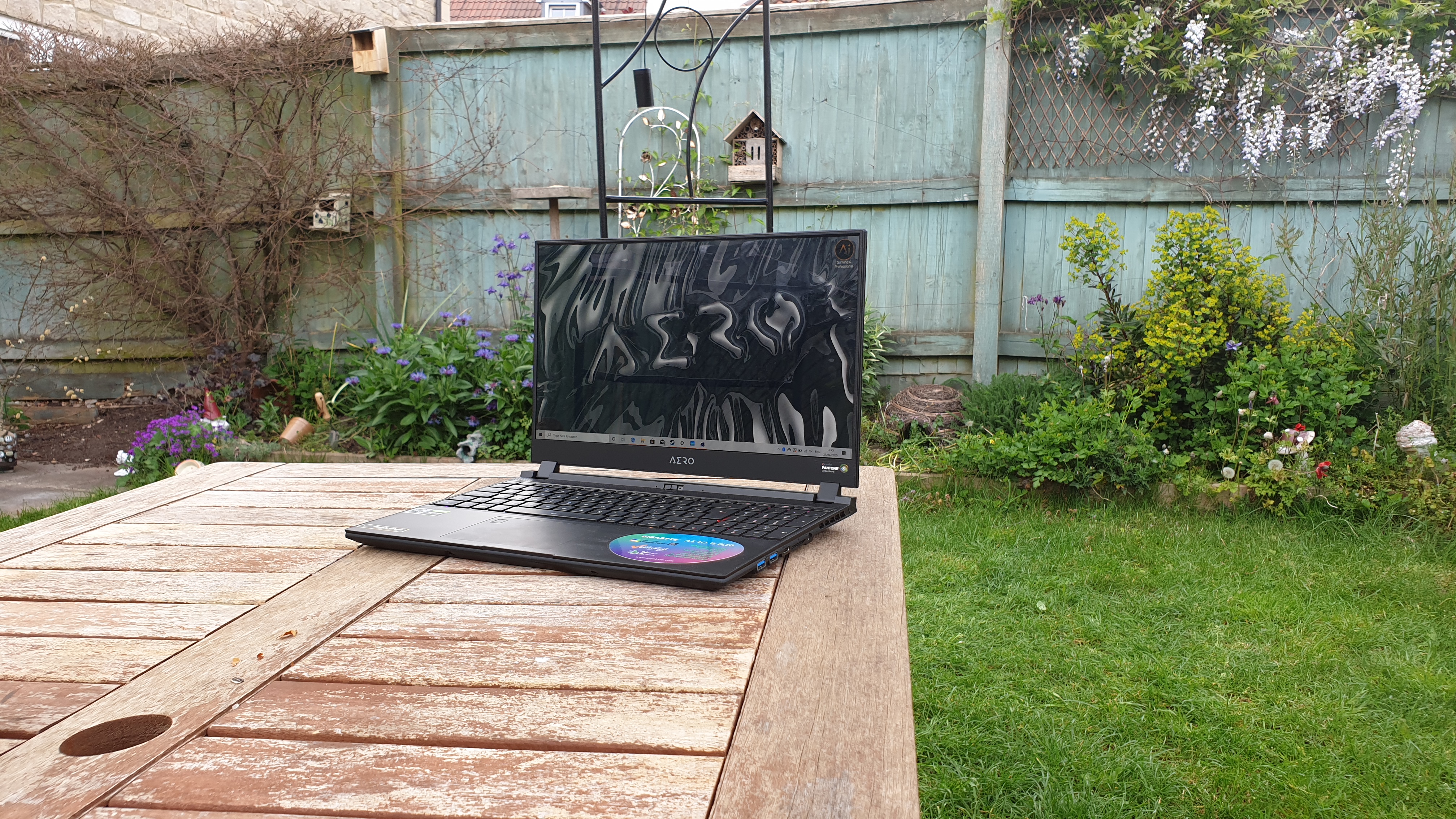
Buy it if...
You want a gorgeous screen to work on
The 4K OLED screen really is the star of the show with this laptop. Apps and media look stunning, as do games – but it really comes into its own when you use it for photo and video editing.
You want a laptop for work and play
The Gigabyte Aero 15 OLED (2020) offers excellent performance both for creative applications and for modern games. The RTX Studio drivers ensure that modern creative apps work well, without compromising on gaming performance.
You want the latest mobile tech
The hardware inside the Gigabyte Aero 15 OLED (2020) is some of the most cutting-edge you can currently get, including 10th generation Intel processors and Nvidia’s new RTX Super mobile GPUs.
Don't buy it if...
You only want to game
While the Gigabyte Aero 15 OLED (2020) plays games very well, if you’re only going to be gaming there are better dedicated laptops out there; otherwise, you’re paying for professional features that you won’t need.
You don’t need the power
The Gigabyte Aero 15 OLED (2020) is a powerful laptop, with a price tag to match, and it’s aimed at creative professionals who perform graphically-intensive work. For many other people, this kind of power won’t be necessary.
You want a long-lasting battery
While the battery life of the Gigabyte Aero 15 OLED (2020) is decent for a workstation/gaming laptop, the laptop will still struggle to make it through a whole day. If you want a laptop that you can happily work on for hours without a power cable connected, look elsewhere.
- The best workstation laptops of 2020

Matt is TechRadar's Managing Editor for Core Tech, looking after computing and mobile technology. Having written for a number of publications such as PC Plus, PC Format, T3 and Linux Format, there's no aspect of technology that Matt isn't passionate about, especially computing and PC gaming. He’s personally reviewed and used most of the laptops in our best laptops guide - and since joining TechRadar in 2014, he's reviewed over 250 laptops and computing accessories personally.
